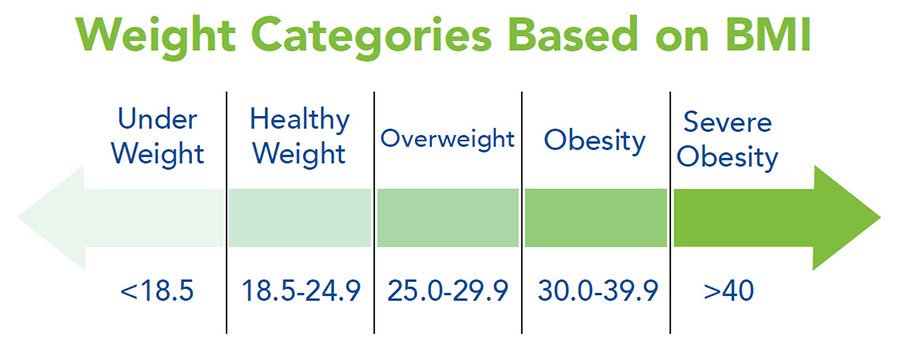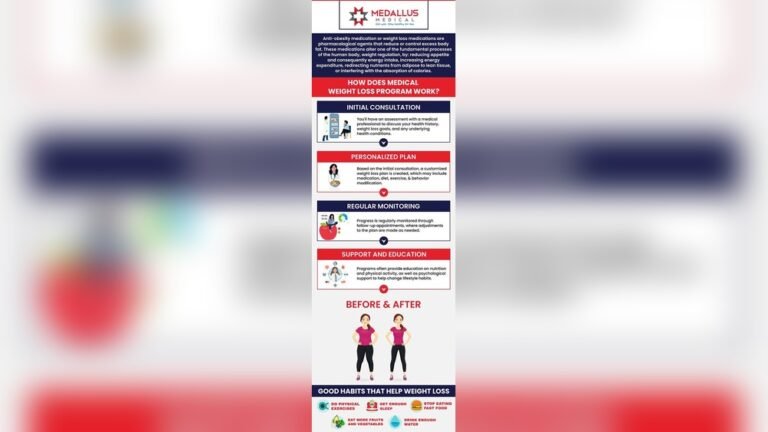What qualifies as obesity? You might think it’s just about weighing too much, but there’s more to it than that.
Understanding whether you fall into this category isn’t just about numbers on a scale—it involves how your body measures weight in relation to height, your metabolism, and even how your hunger works. Are you curious about what really defines obesity and why it matters for your health?
Keep reading to discover the key factors that determine obesity, how it’s measured, and what it means for you personally. This knowledge could change the way you see your body and empower you to take control of your health.

Credit: www.weightlossteam.com
Bmi And Obesity
Body Mass Index (BMI) is a common tool used to define obesity. It gives a quick estimate of body fat based on height and weight. Doctors and health experts often use BMI to decide if a person is underweight, normal weight, overweight, or obese. While simple, BMI helps highlight health risks linked to excess body fat.
Calculating Bmi
BMI is calculated by dividing weight in kilograms by height in meters squared. The formula looks like this: BMI = weight (kg) ÷ height (m)². For those using pounds and inches, the formula is BMI = (weight (lbs) ÷ height (in)²) × 703. This calculation is easy and fast, making it popular worldwide.
Bmi Categories
BMI results fall into several categories. Underweight is below 18.5, normal weight ranges from 18.5 to 24.9, overweight is 25 to 29.9, and obesity starts at 30 or higher. Obesity itself breaks down into classes: Class 1 (30-34.9), Class 2 (35-39.9), and Class 3 (40+), sometimes called severe obesity. These categories help identify health risks and guide treatment plans.
Limitations Of Bmi
BMI does not measure body fat directly. It ignores muscle mass, bone density, and body frame size. For example, athletes may have a high BMI but low body fat. Older adults might have normal BMI but higher fat levels. BMI also does not show fat distribution, which affects health risk. Always consult a doctor for a full health assessment beyond BMI alone.

Credit: en.wikipedia.org
Body Composition And Weight
Understanding what qualifies for obesity involves more than just weight numbers. Body composition plays a key role in this assessment. It looks at different elements that make up the body weight. These include muscle, fat, and bone. Each part affects how weight relates to health. Knowing the differences helps clarify who qualifies as obese.
Muscle Mass Vs Fat
Muscle weighs more than fat but takes up less space. People with high muscle mass may weigh more but are not obese. Fat adds bulk and is linked to health risks. Body fat percentage is a better measure than weight alone. High fat levels often indicate obesity regardless of total weight.
Bone Density And Frame
Bone density and frame size affect overall weight. People with denser bones weigh more without extra fat. Large bone frames add to body weight naturally. These factors can make someone appear overweight on scales. Doctors consider bone structure to avoid misclassifying obesity.
Height’s Role In Weight
Height influences how weight is judged. Taller individuals naturally weigh more due to larger body size. Body Mass Index (BMI) uses height to adjust weight measurement. This helps compare weight fairly across different heights. Shorter people may reach obesity thresholds at lower weights.
Metabolic Types Of Obesity
Obesity is not the same for everyone. Different bodies store fat and react to hunger in various ways. Understanding the metabolic types of obesity helps explain why some people gain weight easier. It also shows why certain diets or plans work better for some than others. Knowing your metabolic type can guide better choices for health and weight management.
Hungry Brain
Hungry Brain obesity happens when the brain signals hunger too often. People with this type feel hungry even after eating enough food. The brain sends strong messages to eat more, causing weight gain. This type needs focus on controlling cravings and meal timing.
Hungry Gut
Hungry Gut obesity is linked to the stomach and digestion. The stomach empties quickly, causing hunger soon after eating. This type often feels hungry all the time. Eating small, frequent meals can help manage hunger and reduce overeating.
Emotional Hunger
Emotional Hunger occurs when feelings trigger eating, not true hunger. Stress, sadness, or boredom can lead to overeating. This type needs to find ways to handle emotions without food. Mindful eating and stress relief help control this type of obesity.
Slow Burn
Slow Burn obesity means the metabolism is slow and burns fewer calories. People with this type gain weight even with normal eating. Exercise and increasing muscle mass can boost metabolism. A balanced diet with fewer calories supports weight loss for this type.

Credit: www.obesityaction.org
Fat Distribution Patterns
Fat distribution patterns play a key role in defining obesity types. They show where fat mainly collects in the body. This affects health risks and treatment plans. Understanding these patterns helps identify obesity better than weight alone. Two common patterns are apple-shaped and pear-shaped obesity.
These shapes describe fat location and how it impacts the body. Each pattern links to different risks and health concerns. Knowing your fat distribution type can guide healthier choices and medical advice.
Apple-shaped Obesity
Apple-shaped obesity means fat gathers around the belly and waist. This pattern is also called central obesity. It raises risks for heart disease, diabetes, and high blood pressure. Fat near organs causes more harm than fat under the skin. People with apple-shaped bodies often face more health problems.
This type is common in men but also appears in women. Waist measurement helps identify apple-shaped obesity. A waist size over 40 inches in men or 35 inches in women signals higher risk. Managing this type needs diet, exercise, and sometimes medical help.
Pear-shaped Obesity
Pear-shaped obesity means fat builds up around hips, thighs, and buttocks. This pattern stores fat under the skin, called subcutaneous fat. It carries fewer health risks than apple-shaped obesity. Pear-shaped bodies often have better heart health and lower diabetes risk.
This fat distribution is more common in women. Waist-to-hip ratio helps identify pear-shaped obesity. A lower ratio shows fat mostly on hips and thighs. While less risky, maintaining a healthy weight still matters. Exercise and balanced diet support managing pear-shaped obesity well.
Medical Criteria For Obesity
The medical criteria for obesity help identify individuals with excess body fat that may harm health. Doctors use specific measurements and classifications to assess obesity accurately. These criteria guide treatment and prevention of related health issues.
Health Risks And Complications
Obesity increases the risk of many serious health problems. These include type 2 diabetes, heart disease, stroke, and high blood pressure. Excess fat can also cause joint pain and breathing difficulties. Mental health issues like depression are common too. Identifying obesity helps prevent or manage these risks early.
Obesity Classes
Obesity is divided into classes based on Body Mass Index (BMI). BMI is a number from weight and height. A BMI of 30 or more means obesity. Class 1 is BMI 30 to 34.9, class 2 is 35 to 39.9, and class 3 is 40 or higher. Higher classes usually mean greater health risks and need for care.
Role Of Healthcare Professionals
Healthcare professionals assess obesity using BMI and other tests. They check for related health problems and overall well-being. Doctors create personalized plans for weight loss and health improvement. Nurses, dietitians, and counselors support patients in lifestyle changes. Early medical help improves chances of better health outcomes.
Beyond Numbers: Personal Factors
Obesity is often judged by numbers like BMI, but personal factors play a big role. Each person’s body reacts differently to food and weight changes. This section explores key personal factors that influence obesity beyond simple measurements.
Appetite And Satiety Signals
The brain controls hunger and fullness signals to the body. Some people feel hungry more often or have trouble feeling full. This can lead to eating more calories than the body needs. These signals vary widely from person to person.
Disruptions in appetite control may increase the risk of weight gain. Hormones like ghrelin and leptin help regulate these feelings. When these hormones are out of balance, it can cause overeating.
Emotional And Psychological Factors
Emotions like stress, sadness, or boredom can affect eating habits. Some people eat more to feel better, which is called emotional eating. This can contribute to weight gain over time.
Mental health issues such as anxiety or depression also impact body weight. Understanding these emotional triggers is important for managing obesity effectively.
Metabolism Variations
Metabolism is the rate at which the body burns calories. Some people have a faster metabolism, burning calories quickly. Others have a slower metabolism, which can cause weight gain even with normal eating.
Age, genetics, and muscle mass affect metabolism speed. Slower metabolism means the body stores more fat from the same amount of food. Knowing your metabolic rate can help tailor weight management plans.
Tools For Assessment
Assessing obesity requires accurate tools to measure body size and fat levels. These tools help determine if a person falls within the obese category. They offer quick, simple, and reliable ways to understand body health. Below are common tools used for obesity assessment.
Bmi Calculators
BMI calculators use height and weight to estimate body fat. The formula is weight in kilograms divided by height in meters squared. BMI scores classify people as underweight, normal, overweight, or obese. A BMI of 30 or higher usually indicates obesity. This tool is easy to use and widely accepted. It does not directly measure body fat but offers a useful estimate.
Body Fat Measurement Methods
Body fat measurement methods give a clearer picture of fat levels. Techniques include skinfold calipers, bioelectrical impedance, and DEXA scans. Skinfold calipers pinch the skin to estimate fat thickness. Bioelectrical impedance sends a small electrical current through the body to measure fat. DEXA scans use X-rays to provide detailed body composition data. These methods are more accurate than BMI alone.
Professional Evaluations
Healthcare professionals use multiple tools to assess obesity. They consider medical history, physical exams, and lab tests. Doctors may evaluate waist circumference and fat distribution. Professionals look at health risks linked to obesity, such as diabetes or heart disease. This evaluation helps create personalized treatment plans. It ensures a comprehensive understanding of a person’s health.
Conclusion
Obesity means having excess body fat that may harm health. Doctors often use BMI to measure obesity, but it isn’t perfect. Muscle, bone, and body shape can affect BMI results. Different types of obesity exist, based on how the body controls hunger and metabolism.
Understanding these types helps in managing weight better. Always talk to a healthcare professional for accurate diagnosis and advice. Taking small, healthy steps improves overall well-being and reduces obesity risks. Stay informed and focus on balanced habits for a healthier life.



